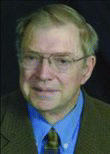Abstract
Copyright 2013 American Association for Aerosol Research
Jim Gentry, a distinguished member of the aerosol community, passed away on October 2, 2012, after a long illness. He was a charter member of the American Association for Aerosol Research (AAAR) and provided exemplary service to the society since its inception. He was the co-chairman of the 2nd AAAR Meeting, held in College Park, Maryland, in 1983, and served the society in various capacities, including memberships on the AAAR Board of Directors, the AAAR awards committee, the program committee, and the History of Aerosol Science working group. He attended all the AAAR meetings until the 29th Annual Conference, in Portland, Oregon (2010), in spite of the fact that he had to go through kidney dialysis treatments during the last two meetings. He made significant contributions to research and education in the field of aerosol science. In 2000, he received AAAR's David Sinclair Award in recognition of his sustained excellence in aerosol research.
After graduating from Hobart High School, Oklahoma, Jim attended Oklahoma State University (OSU) to study Chemical Engineering, receiving a B.S. degree with honors in 1961. He was a member of the University team that appeared twice during the 1960–1961 session of the GE College Bowl, a popular TV show that ran live on CBS. As one of the first OSU recipients of a Fulbright Fellowship, he went to the University of Birmingham, England, where he received a M.S. degree in Chemical Engineering in 1963. Following that, he studied Chemical Engineering at the University of California at Berkley and the University of Texas (UT), where he did his Ph.D. research work under the supervision of the internationally renowned aerosol scientist, James Brock. After receiving his Ph.D. degree in 1969 from UT, he joined the Chemical Engineering faculty of the University of Maryland as an assistant professor and became a full professor in 1978, a position he occupied until his retirement in 2002.
Jim contributed immensely to aerosol science through his research activities spanning over 40 years. He worked on a variety of problems related to physical and chemical processes associated with small spherical and non-spherical particles. His major research areas included particle charging, aerosol dynamics, aerosol generation and characterization, collection, filtration and diffusion of particles, and droplet drying morphology. In each of these areas, he made either significant or seminal contributions, and he tackled difficult problems involving non-spherical particles such as fibers and soot agglomerates. His approach was always to conduct critical experiments using innovative techniques, and support the results on the basis of fundamental theoretical analysis. In addition, he developed a number of numerical techniques for inverting experimental data to decipher meaningful information. Jim was one of those rare breed of experimentalists who possessed strong theoretical and mathematical backgrounds. He published more than 200 papers and advised about 50 graduate students.
During his professional career, he played active roles as a member of the Asian, European, and North American aerosol societies. In addition to AAAR, he regularly participated in the meetings of Asian and European aerosol societies. He served in numerous roles in the Gesellschaft fur Aerobiologie (GAef), including two terms as a member of the Board of Directors, and as the official representative at the founding meeting of the UK Aerosol Society. In addition, he collaborated with a number of well-known aerosol scientists in Germany and spent many months as a visiting scientist at various German research institutions including the Institut für Aerobiologie (Schmallenberg), Kernforschung Zentrum (Karlsruhe), and GSF (Frankfurt and Munich). In recognition of his research and service contributions, he received several awards, most significantly, the Humboldt Senior Scientist Award in 1993, the International Fellow Award in 1996, and Sinclair Award in 2000.
One significant but little known contribution of Jim was his caring interest in the advancement of young scientists. Jim mentored a number of young aerosol scientists by providing them with valuable advice and promoting their research. In addition, he wrote letters supporting their tenure and promotion. He also played a valuable role in the decision-making processes for aerosol science related awards. He not only served on AAAR and GAef award committees, but also nominated or provided supporting letters for a number of young and senior scientists for various awards. A major fraction of these nominees received awards such as the Fuchs Award, Junge Award, International Aerosol Fellows Award, David Sinclair Award, Whitby Award, Smoluchowski Award, B. Y. H. Liu Award, and T. T. Mercer Award.
On a personal level, Jim was a close friend of mine, and we spent many hours together. Jim's knowledge of science, history, literature, architecture, sports, and national and international affairs always amazed me. He was an avid reader with encyclopedic knowledge. He was unassuming and never flaunted his keen intellect and depth of knowledge. He published several papers on the history of science that included publications on Michael Faraday, John Tyndall, and Joseph Lister.
Life was not kind to him for the last few years. He lived under physically debilitating conditions, but his mind was as sharp as ever. Under these difficult circumstances he was always eager to participate in the aerosol conferences. During this period, I had the opportunity to accompany him to a number of domestic and international conferences. He needed hospitalization during the 2011 European Aerosol Conference in Manchester. Even though he was planning to attend; his physical condition prevented trips to 2012 conferences. He loved his brother and sister-in-law, and doted on his nieces and nephews. He moved to Norman, Oklahoma, to remain close to his family and childhood friends. His death has been a personal loss to many of us. He will be sorely missed by his family, friends, and professional colleagues, and his absence at future aerosol conferences will be deeply felt.
